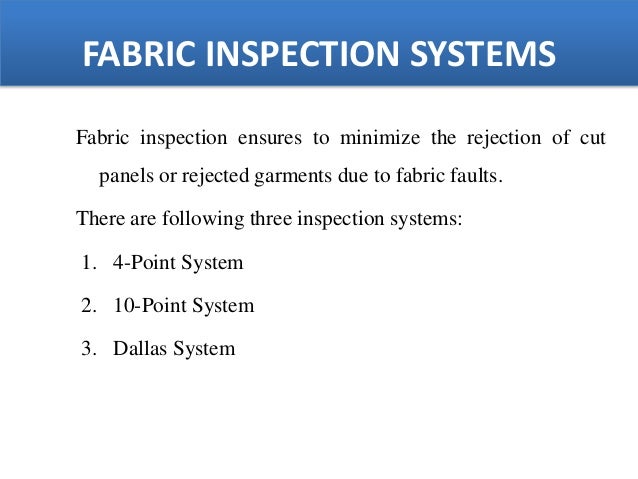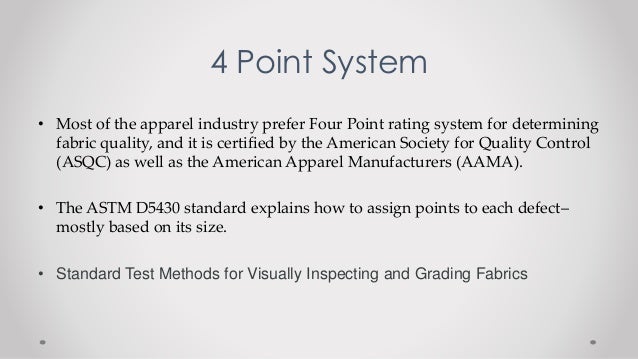Basics about fabric defects and fabric inspection methods:
As Paramount has ventured into making a range of fabric inspection machines called Check MASTERS, our customers have been coming to us time and again, asking us to provide information in regard to the fabric defects and the common visual inspection methods for the fabrics. This is my attempt to provide a brief detail in regard to the common fabric defects and inspection methods for checking the fabrics. I will be covering the following three aspects in this article:
- Common fabric defects
- Fabric inspection methods
- Acceptability criteria of the flaws in fabric inspection methods.
Fabric defects:
For the purpose of convenience, fabrics defects can be classified in three main categories as below:
When a sewing factory receives fabric from the mill, it is difficult to conduct a full 100% inspection of the fabric. A minimum 10% inspection of all piece goods prior to spreading the fabric is recommended. Fabric Inspection Systems. There are various fabric inspection systems: 10-Point System. Graniteville '78' system. There are different systems for fabric inspection, such as 4 Point System, 10 Point System, 2.5 Point System, Grantville System etc. But in the above mentioned systems, or in any other systems, there are no arrangements until recently, for considering of the shade, bias, handling etc., of fabrics.

- Woven Fabric Defects
- Knitted Fabric Defects
- Printed Fabric Defects.
- Fabric inspection focuses on fault/defect rate color, end to end and edge to middle shading, hand/handle, and appearance. The client will select the appropriate fault rate and standard to determine the acceptance of each shipment. This will minimize the quantity of panels or garments rejected for fabric faults, thereby ensuring the quality of the finished goods.
- 10 POINT SYSTEM For production of high quality garments, need high quality piece goods. It is an universal truth. When a sewing factory receives fabric from the mill, it is difficult to conduct a full 100% inspection of the fabric. So then minimum 10% inspection of all piece goods prior to spreading the fabric.
Knitted fabric defects:
Barre: A noticeable stripes in the direction of the weft-wise. Some of the causes are uneven yarn and uneven tension.
Birdseye:An unintentional tucked stitch which appear occasionally on the knitted fabric. Coarse yarn: A yarn having a large diameter than that normal to the fabric. Dropped stitches: When a stitch failing to form because of malfunctioning needle. Fine yarn: A yarn having a smaller diameter than normal to the fabric.
Misdraw (color): In warp knits, the colored yarns are wrongly drawn through the guide bar which causes the appearance of the fabric different from the designated pattern.
Missing yarns: A yarn is missing or broken which the machine continuing to run. Needle line: Wales are distorted caused by a bent needle.
Press-off: A condition in which a knitted fabric fails to knot and as a result, either the fabric falls off the needle or the design of the fabric is completely destroyed.
Run: A vertical line of unformed stitches caused by damaged needle.
Tucking defect: One or more unwanted tuck stitches appear on the knitted fabric which are occurred due to the malfunctioning needle or jack.
Printed fabric defects:
Color out: Some printing pattern
Color smear: The color smeared out during printing.
Out of register: The color printed not in a proper position during printing.
Scrimp: The printing pattern is broken due to fabric creased during printing.
Snap: During printing, the doctor blade is held from the engraved roller by a hard particle which is lodged under the blade. As a result, the color escapes from both sides of the particle.
Fabric inspection methods:
The inspection of fabric has two primary functions; first to classify the products according to the different quality based on the demands of the buyer/market or client and second to provide the information about the quality being produced.
During the inspection the fabric may be found to contain different defects. The defects depending on the magnitude, frequency of occurrence, position, importance, effect on the purpose, consequence in the further process etc., shall be classified and graded under various systems. During the inspection, the occurrences of various defects need to be examined and graded based on their magnitude and dimension as per the required system. There are two most common types of systems for grading the defects:
- 4 – Point System.
- 10-Point System.
4 – Point system:
It is an inspection method used for the visual checking of fabric quality, faults are scored with penalty points of 1, 2, 3 and 4 according to the side and significance. The 4-point system, also called the American Apparel Manufacturers’ Association (AAMA) point-grading system for determining fabric quality, is widely sued by producers of apparel fabrics and by the Department of Defense in the United States and is endorsed by the AAMA as well as the ASQC.
Highlights of 4-point system:
Normally apply for woven and knitted fabric inspection. Assign no more than a total of 4 points to any one linear yard of fabric regardless of the number or size of the detected individual defects. A continuous defect running over 9″ shall be assigned 4 points for each yard. Assign 4 points to each full width defect. For holes and openings (largest dimension) of 1 inch or less should be assigned 2 points and the one which are over 1 inch needs to be assigned 4 points. Total defect points per 100 yd2 are calculated. Though this inspection method establishes a means of numerical designation which may be used for assessing the quality of fabric, the acceptance of fabric is depends on the requirements mutually agreed upon by seller and buyer.
4 – Point system acceptability criteria:
Normally products containing up to 40 points per 100 yd2 are acceptable. However, based on the price line and end product more or less than 40 points per 100 yd2 may be accepted. For example, a fabric roll 120 yd long and 48 in. wide contains the following defects:
2 defects up to 3 in 2 x 1 = 2 points
5 defects over 3 in. but less than 6 in 5×2=10 points
1 defect over 6 in. but less than 9 in 1 x 3 = 3 points
1 defect over 9 in 1 x 4 = 4 points
Total points = 19
Therefore,
Total points scored in the roll x 3600

Fabric width in inches x Total yard inspected
_ 19×3600 48×120
= 11.9 defect points/100 yd2.
So if the acceptance criteria are 40 points/100 yd2, then this roll is acceptable.
Fabric Inspection System

The acceptability level for first quality fabric is usually established by mutual agreement between the buyer and the seller. The different type of fabrics have different point levels of acceptability depending upon their end use. Some of the commonly followed standards for acceptability for the above mentioned systems are as below:
Note: The maximum number of defect points to be counted against any one linear yard is 4 points. Overall, fabric quality is assessed on the basis of the number of defect points per 100 yd2 of fabric.
4 Point Fabric Inspection Standards
CONCLUSION:
Fabric Inspection 4 Point System
The project has come to a termination finally after lots of thinking, discussion and we uninterrupted trying. We really have worked hard to complete this project well ahead. We wished to make it as a replica of production so that it provides a complete knowledge about merchandising. Though there were some limitations like shortage of time that compelled us to complete the thesis as soon as possible, even then we have tried to give our best.
